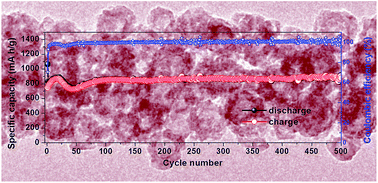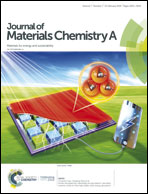Oxidizing solid Co into hollow Co3O4 within electrospun (carbon) nanofibers towards enhanced lithium storage performance†
Abstract
Transition metal oxides (TMOs) have been regarded as promising anode materials for lithium-ion batteries (LIBs) owing to their high theoretical capacities, natural abundance, and eco-friendliness. However, their large volume changes and the thus resulting pulverization problem, as well as the poor electrical conductivity, have hindered their practical applications. Design of hollow nanostructures with simultaneous carbon hybridization has shown great promise to overcome these drawbacks. Herein, we demonstrate a facile strategy to fabricate hollow Co3O4 nanoparticle-assembled nanofibers with controllable carbon content via electrospinning and subsequent annealing. Interestingly, the solid Co nanoparticles encapsulated within carbon nanofibers convert into hollow Co3O4 counterparts under ambient oxidation in air, and the carbon content can be easily adjusted by controlling the annealing temperature/time. When used as anode materials for LIBs, the hollow Co3O4 nanoparticle-assembled nanofibers (no carbon left) deliver a high discharge capacity of 1491.5 mA h g−1 after 180 cycles at 200 mA g−1, demonstrating superior lithium storage properties. Notably, optimized Co3O4/C nanofibers with 10 wt% carbon content demonstrate superior cycling stability, delivering a stable reversible capacity of ∼871.5 mA h g−1 after 500 cycles at 200 mA g−1. The superior electrochemical performance of the Co3O4(/C) nanofibers could be ascribed to the unique hollow nanostructure of Co3O4, the carbon hybridization, and the novel hierarchical nanoparticle-nanofiber assembly, which could not only shorten the lithium diffusion length, but also efficiently buffer the volumetric changes upon repeated lithiation/delithiation processes.



 Please wait while we load your content...
Please wait while we load your content...